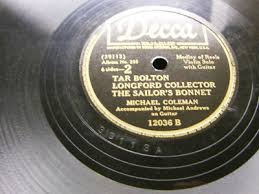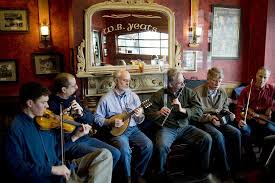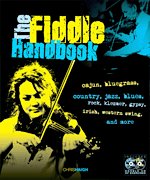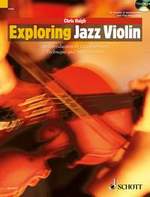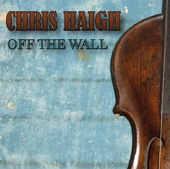
MENU TO FIDDLE STYLES:
Playing tunes in sets; why do we do it?
When you first start out playing fiddle, you will probably learn one or two simple individual tunes, either by ear, from a book, or at a workshop or lesson. After a while it will occur to you that, whether in a session, at a gig, at a dance or on a recording, traditional tunes are almost universally played in groups, sets or medleys- each tune played two or three times before running seamlessly into the next. Selection of tunes to group in this way is an art in itself. In this article I will look at what is involved in choosing tunes for a set, and what it aims to achieve. But I also want to answer a very interesting question. Were tunes always played in groups like this, or is that a relatively modern invention?
It is my contention that before the 20thC, tunes were in fact almost always played individually. Dancing was the main purpose of playing these tunes, and musicians would play a single tune for as long as the dance lasted. This was not because of a lack of repertoire, but simply that, as was probably the case in dance traditions throughout the world, the tune and the dance were seen as part of the same thing. The concept of dance music played purely for listening was still a rarity. It was not until the advent of the recording industry in the 1920’s that there was a separation of music for dancing and music for listening. In the context of a dance, the attention of an audience is divided between the movement on the dance floor, the physical presence of the musicians, and the music itself. On record however, all you have is the sound of the music, and repeated playing of the same 32 bars of tune would quickly lose its appeal. The 78rpm disks which were used in the early 20’s would hold around 3 minutes of music- more than enough time to exhaust the interest of a listener in a single tune. The studio engineers and record executives would have had little experience or indeed interest in the original context of the music they were recording, and they would impose their own ideas of what constituted good musical practice. In the case of master Irish/American fiddler Michael Coleman, for example, this included pairing him with some abysmally inappropriate piano accompaniment. The record executives would also have jumped at the chance of including two or three tunes on a single side rather than just one, as this would not only add more musical variety, but also attract more buyers simply on the basis of the multiple titles. The medleys or sets recorded by Coleman, such as The Tarbolton/The Longford Collector/The Sailor’s Bonnet, or The Morning Dew/The Woman of the House, were so successful and influential that even today Irish musicians anywhere in the world will be familiar with the sets, even if they have never heard the original recordings.
We will probably never know for certain, but it is quite possible that these sets were cobbled together on the day of the recording and had never been played before.
So is there any other evidence either for or against the idea that medley playing began in the 20thC? Our main source of evidence for repertoire and style of tune playing before the days of recording is the study of the hand-written manuscripts of contemporary musicians. Take a look at the “pad” of any ceilidh band today, and you will see the tunes written out in groups. Or if a tune is on its own, there is a good chance there will be a scribbled note at the bottom suggesting what other tunes it could lead into. Surely if tunes were played in this way in earlier times, the manuscripts would at least hint at this. I am no expert on early tune collections, but I had a word with Andrew Kuntz, creator of the encyclopaedic online tune collection “The Fiddler’s Companion”, and its successor “The Traditional tune Archive”. If you’re looking for information on virtually any traditional tune, these archives will have the answer.
Andrew told me
“My passion has been tracing tunes in handwritten manuscripts., but I can tell you that in reviewing dozens of manuscript collections from England, Ireland, Scotland, and the US, there is little evidence that I have seen of set playing”
If this is indeed the case, it immediately brings up further questions. Firstly, how did fiddlers “get away with it”? Were they more inventive and creative than today’s musicians, so that they could maintain interest despite endless repetition of a tune? As Andrew explained,
“I can't credit that 19th century fiddlers were more inventive than today’s fiddlers, but I don’t think they were as social in their music making, and that there was much more solitary playing. There's certainly ample pictoral evidence in paintings and drawings, of solo musicians playing for dances. I suspect the demands on a dance fiddler were less in the 19th century, and that audiences did not expect tunes to change, nor did they expect variation/innovation in melody. Perhaps that was appreciated by some when it happened, but I think the focus was on the dancing and not the accompaniment. The music was simply a means to facilitate the dance, and not all that important in and of itself. I think dance audiences have grown much more sophisticated since then, and more demanding of the musicians. Certainly in my own local contra dance scene in the Hudson Valley, dancers want innovative, exciting bands to dance to; simply playing trad. tunes, even skilfully, will not do.
As you point out, there was no recorded music in the 19th century, so there was relatively little comparison going on. I think a dance fiddler then was probably measured by the steadiness of their rhythm and perhaps drive of their playing, not their melodic inventiveness.”
I think there is a strong case that, at least in England, set playing is indeed a recent phenomenon. However, Scotland may be a different case. I spoke to Paul Cranford, of Cranford Publications, who drew my attention to the tradition of grouping strathspeys and reels as early as the late 18thC
“I think the playing of dance tunes in medleys began with Scottish fiddlers in the late 18th/early 19th century, and initially may not have extended much beyond a musically literate elite working the gentry market. The Gow family publications, for example, include some medley selections, and I can recall at least one direct reference to Gow playing (or rather attempting unsuccesfully to play) a Bb strathspey and reel medley” “If we take late 18th century Scotland as our starting point, it is easy to imagine the practice spreading to England and Ireland among musically literate professionals, perhaps accompanying the spread of Scotch reels, but it really is very hard to judge how rapidly or widely the practice did or didn’t spread before the 20th century, outside Scotland at least”
Niel Gow
Cranford, then, makes a strong case for a much earlier use of medley playing in Scotland. However, he is referring to the special case of grouping reels and strathspeys, whereas the modern concept of set playing is much more about playing multiple tunes of the same type. There is no doubt, however, that any fiddler hearing a reel/strathspey medley for the first time would have been struck by the musical drama of the transition, and it would have been an attractive idea to copy.
Whether it was the Scots who introduced the idea, or the record companies of the early 20thC, once set playing started it quickly became a universal practice. It was well suited to the many new contexts of traditional music playing. In the 1930’s, for example, in Ireland, the notorious Public Dance Halls Act put an end to informal, small scale music making, but at the same time led to the formation of many Céilí bands. These were larger, louder and more disciplined groupings than had been seen before, and they were well suited to playing pre-determined medleys of tunes, with less emphasis on variation and ornamentation, and more on strict rhythm and regular changes of tune within a single long dance.
With the advent of the folk revival in the 60’s and 70’s, traditional music began to appear both in folk clubs and increasingly in concert halls. In this context the separation of music for dance and music for listening was increased, and the music definitely had to stand on its own two feet. Again set playing was invaluable in providing richness and variety.
Another relatively new context was the advent of playing music in pub sessions which, surprisingly to many, did not actually begin until the 1940’s. A session is an informal grouping of traditional musicians who meet on a regular basis to play for their own enjoyment. A typical set at a session would be a grouping of three or four reels, each played two or three times. They would be started and led by one person, with members of the group dipping in or out depending on whether or not they know each tune. A session where all tunes were played singly would be an odd session indeed, and most of the flow and excitement would be missing.
So what makes a good set? Some specific tune groupings, as we have already seen, were established simply because so many people heard and learned from a few famous recordings. It soon became obvious that the selection of sets should not be just a random affair, but that with careful thought, each change of tune could add its own change of colour or spark of excitement.
A change of key or mode is often a good idea. Major to minor or minor to major works well. Usually only one sharp or flat is added at a time, so that the keys are closely related. A classic sequence would be G major to D major to A minor, or another would be E minor to D major to A major. The phrasing or tunes can be an important factor, as can the notes at the very end of the tune leading into the next one; some links are very neat, while others will always sound clumsy. If drama and surprise is what you are looking for, a change such as A major to Bb major will bring the house down.
For some people, the linking of tunes is not just an art, but also a competitive sport. Andrew Kuntz drew my attention to the Canadian practice of competitive set playing, also known as “fiddle elimination” or “Pure Laine”. A group of fiddlers sit in a circle, and one starts off with a reel; at the end of a single playing, the person to their right takes over with a new reel, without breaking the beat, pausing, or repeating what has been played before. Anyone who makes a mistake is eliminated, and the set goes round and round the circle until only two are left. At this point, the final two play just a single A section each, greatly heightening the excitement. Fiddler April Verch can be seen on several youtube clips competing, and she told me that to win requires not only a huge repertoire, but also a cool head and the ability to think very quickly.
So are we to regard the playing of sets as a great step forward in the practice of traditional music, a natural evolutionary leap? Certainly not everyone thinks so. For some people, both players and listeners, there should be sufficient beauty, individuality and interest in a single tune, and that to package them together merely cheapens them. For a top class player, subtle variation, either spontaneous or prepared, should make it possible to play a tune round many times without any loss of interest. The very first country fiddle recording was by Texan “cowboy fiddler” Eck Robertson in 1922, and one of his opening numbers was the old time classic Sally Goodin, which he played no less than 12 times, each one a perfectly executed variation in the Texas contest style of which he was a master. The tune, however, was not a hit, and the record companies quickly realised that, in country music at least, instrumental virtuosity was not a guarantee of commercial success.
Eck Robertson
An example from much closer to today would be Irish fiddler Martin Hayes, who has always pursued an individual and thoughtful approach to tune playing. He is known for deliberately slowing reels to well below dance tempo in order to fully explore the fine detail of individual notes and phrases. On his 2008 album “Welcome here again” he deliberately chose to record most of the tunes individually, with only a few sets. The results are magical. On the sleeve notes, he comments
“There are as many ways to play Irish music as there are people to play it. One of its greatest strengths is in its flexibility of interpretation; everyone has the opportunity to put their personal stamp on it”
Another long-time champion of exploration and variation is accordionist John Kirkpatrick, for whom this is a hot topic. Some years ago I interviewed him for my “Exploring Folk Fiddle” book, and he was adamant that, not only was the playing of single tunes the norm from the 17th to the 19thC, but that folk music has lost a great deal since the idea disappeared;
“When I started playing for dancing, I worked out medleys of tunes for each dance, like most other people were doing, but found I got so engrossed in exploring the possibilities of the first tune that I never got around to any of the others. I think it’s also extremely interesting and pertinent to point out that for some hundreds of years, everybody was united in the idea that each dance had just one tune that the musicians would play continuously for as long as necessary.
There is a well known description of Thomas Hardy playing The Devil among the Tailors non-stop for 45 minutes when he was a young lad. This idea only changed when records started being made in the late 1920’s and as technical improvements allowed longer playing time on the recordings, commercial competition among the companies involved led to the players being prompted to include more than one tune on the records. So the idea of medleys, or sets of tunes, was prompted by commercial concerns, not from any traditional practice. If a record had more tunes on it, more people would buy it.
I know this is true, because on one occasion I met Jimmy Shand and asked him why he’d changed from playing just one tune a few times through on his earlier recordings, to playing sets of two, three or more later. He said the record companies made him do it so he would sell more. Now we think it’s normal and must always have been done. I think it’s tragic”
This article first appeared in Living Tradition magazine
POSTSCRIPT
Since this article was published, several people have got in touch to point out that in various continental European traditions, it still remains the norm to play a single tune for a single dance.
David Hastie told me:
"I have just read your article and found it very interesting indeed. I play traditional music and have often wondered why the Scots, Irish and others play tunes in sets but bands in other countries don’t. I started to learn whistle in Aberdeen with SCaT, a teaching organisation, at the age of 52. 16 years later after 6 years in Aberdeen, 11 years in Denmark and a wee while in France, I now have an explanation for the one tune-one dance thing. When I was in Denmark, I played with a band called Ribe Spillemandslaug and I was puzzled why they didn’t play tunes in sets. Funnily enough, I never asked! I just went along with it. After we moved to France, I joined a French organisation based near La Rochelle, called Les Etournias, and again, I was surprised that they also play one tune-one dance, and like Denmark, it doesn’t seem to matter how long the dance is!!! So, why is it that it seems to be only in the British Isles and places linked to that Celtic scene that it was only this part of the culture that developed playing music in sets? Mainland Europe developed records as well. So why didn’t they change to the multiple tune set format? Do you think that they just hung on to the traditional way of doing it? I don’t know. "
